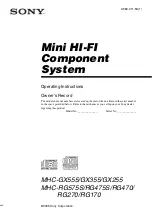
DL32R Owner’s Manual
27
Condenser
— Another term for the electronic component generally known as a capacitor. In audio,
condenser often refers to a type of microphone that uses a capacitor as the sound pickup element.
Condenser microphones require electrical power to run internal amplifiers and maintain an electrical
charge on the capacitor. They are typically powered by internal batteries or phantom power supplied
by the mixer.
Console
— Another term for mixer. DL32R mixer = DL32R console.
D/A Converter
— Digital-to-analog converter. A device that transforms incoming digital signals into
analog form.
dB
— See decibel.
dBu
— A unit of measurement of audio signal voltage in an electrical circuit, expressed in decibels
referenced to 0.775 VRMS into any impedance. Commonly used to describe signal levels within a
modern audio system.
Decibel (dB)
— The dB is a ratio of quantities measured in similar terms using a logarithmic scale.
Many audio system parameters measure over such a large range of values that the dB is used to
simplify the numbers. A ratio of 1000:1 = 60 dB. Since dB is a unitless quantity, it doesn’t matter if it’s
volts or dollars. (Just try asking the chief engineer for a 3 dB raise). When one of the terms in the ratio
is an agreed upon standard value, such as 1.23 V, 1 V or 1 mw, the ratio becomes an absolute value.
For example, +4 dBu, –10 dBV or 0 dBm.
Delay
— Delay “delays” the audio signal for a short period of time. Delay can refer to one short repeat,
a series of repeats or the complex interactions of delay used in chorusing or reverb.
Dipping
— The opposite of peaking, of course, used in audio to describe the shape of a frequency
response curve. A dip in an EQ curve looks like a valley, or a dip. Dipping with an equalizer reduces
a range of frequencies. (See guacamole).
Doubling
— A delay effect where the original signal is mixed with a medium (20 to 50 ms) delayed
copy of itself. When used carefully, this effect can simulate double-tracking [recording a voice or
instrument twice].
Dry
— Dry means without effects. It is just the signal alone; no reverb, no delay, etc.
DSP
— Digital Signal Processing accomplishes the same functions found in analog signal processors,
but performs them mathematically in the digital domain, with more precision and accuracy than its
analog counterpart. Since DSP is a software-based process, parameters and processing functions are
easily changed and updated be revising the Master Fader app.
Dynamic Microphone
— The class of microphones that generate electrical signals by the movement
of a coil in a magnetic field. Dynamic microphones are rugged, relatively inexpensive, capable of very
good performance and do not require external power.
Dynamics Processor
— A type of processor that only affects the overall amplitude level of the signal
(sometimes as a function of its frequency content), such as a gate, compressor, or limiter.
Dynamic Range
— The range between the maximum and minimum sound levels that a sound system
can handle. It is usually expressed in decibels as the difference between the level at peak clipping and
the level of the noise floor.
Echo
— The reflection of sound from a surface such as a wall or floor. Reverberation and echo are terms
that are often used interchangeably, but in audio parlance a distinction is usually made: echo is considered
to be a distinct, recognizable repetition (or series of repetitions) of a word, note, phrase or sound, whereas
reverberation is a diffuse, continuously smooth decay of sound.
Glossary Of Terms Continued...










































